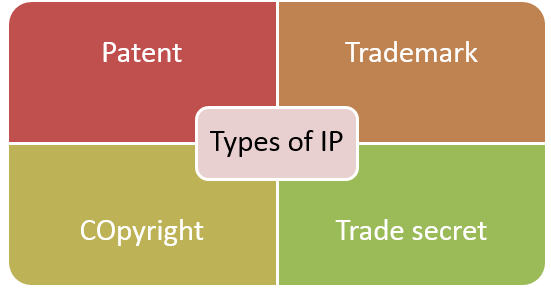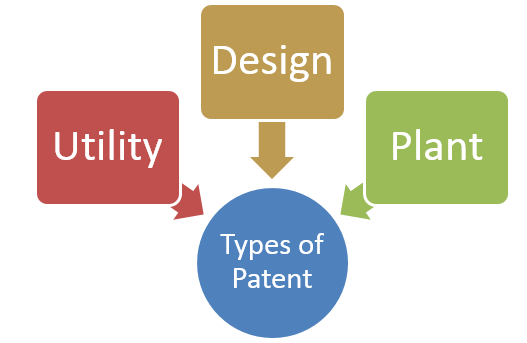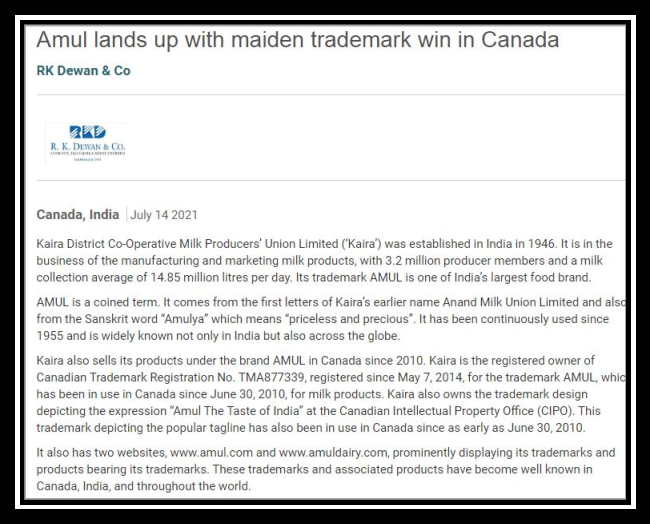Unit - 1
Introduction to Intellectual property
Intellectual property (IP) rights are legal and institutional devices to protect creations of the mind such as inventions, works of art and literature, and designs. Intellectual property right is the legally enforceable power to exclude others from using the information created or to set the terms on which it can be used. The objective of the agreement on TRIPS is to give adequate and effective protection to the intellectual property rights to reward creativity and inventiveness. TRIPS sets out minimum protection to be given to each category of intellectual property in the national laws of each WTO member. It lays down procedures and remedies to be provided by each country for intellectual rights enforcement. The agreement on TRIPS lays down minimum standards of protection that countries must provide for intellectual property rights. One of the other important features of the agreement is that it also requires countries to ensure effective enforcement of these rights. Its rules apply to:
- Copyright and related rights;
- Trademarks;
- Patents;
- Geographical indications;
- Industrial designs;
- Layout designs of integrated circuits; and
- Undisclosed information.
According to WTO, Intellectual property rights are the rights given to persons over the creations of their minds. They usually give the creator an exclusive right over the use of his/her creation for a certain period of time.
Intellectual property rights in India
India is one of the UKs priority overseas markets. If you plan to do business in India, or if you are already trading there, it is essential to know how to use, guard and enforce the rights you have over the intellectual property (IP) that you or your business own. This guide explains about IP in general, and gives guidance on how to apply these principles in the Indian market. It describes the issues you may face with IP infringement in India, offers advice on how you can effectively tackle these, and provides links to sources of further help. Intellectual property (IP) is a term referring to a brand, invention, design or other kind of creation, which a person or business has legal rights over. Almost all businesses own some form of IP, which could be a business asset. Common types of IP include:
- Copyright – this protects written or published works such as books, songs, films, web content and artistic works;
- Patents – this protects commercial inventions, for example, a new business product or process;
- Designs – this protects designs, such as drawings or computer models;
- Trade marks – this protects signs, symbols, logos, words or sounds that distinguish your products and services from those of your competitors.
IP can be either registered or unregistered. With unregistered IP, you automatically have legal rights over your creation. Unregistered forms of IP include copyright, unregistered design rights, common law trade-marks and database rights, confidential information and trade secrets. Registered forms of IP include patents, registered trade-marks and registered design rights. Copyright is also registerable.
India is also a signatory to the following international IP agreements:
- The Paris Convention – under this, any person from a signatory state can apply for a patent or trade mark in any other signatory state, and will be given the same enforcement rights and status as a national of that country would be;
- The Berne Convention – under this, each member state recognises the copyright of authors from other member states in the same way as the copyright of its own nationals;
- The Madrid Protocol – under this, a person can file a single trade mark application at their national office that will provide protection in multiple countries;
- The Patent Cooperation Treaty – this is a central system for obtaining a ‘bundle’ of national patent applications in different jurisdictions through a single application.

There are four types of intellectual property. These are discussed below-

Figure: Types of IP
- Patent
A patent is used to prevent an invention from being created, sold, or used by another party without permission. Patents are the most common type of intellectual property rights that come to people’s minds when they think of intellectual property rights protection. A Patent Owner has every right to commercialize his/her/its patent, including buying and selling the patent or granting a license to the invention to any third party under mutually agreed terms.
There are three different categories that patents can fall under:

Figure: Types of patent
a) Utility:
A utility patent protects the creation of a new or improved product, process, composition of matter, or machine that is useful.
b) Design:
A design patent protects the ornamental design on a useful item.
c) Plant:
A plant patent protects new kinds of plants produced by cuttings or other nonsexual means.
For example,
- Pen with scanner
With a machine as small as a pen, you can transfer text from paper directly into a computer. Christer Fåhraeus invented the C-pen.
- Steel kidneys
After receiving a grant from the state in 1946, Nils Alwall, a doctor in Lund, began developing a dialysis machine for people suffering from kidney disease. Just over twenty years later, his inventions started to be mass produced.
2. Trademark
Trademarks are another familiar type of intellectual property rights protection. A trademark is a distinctive sign which allows consumers to easily identify the particular goods or services that a company provides. Some examples include McDonald’s golden arch, the Facebook logo, and so on. A trademark can come in the form of text, a phrase, symbol, sound, smell, and/or color scheme. Unlike patents, a trademark can protect a set or class of products or services, instead of just one product or process.

The Trademarks Act, 1999, allows the registration of various types of trademarks such as word marks, service marks, collective marks, certification marks, series marks logos/symbols and many other. Such types are-

Figure: Types of trade mark
a. Word Marks
Word Marks are the most common types of trademarks that are registered in India. These refer to any marks that are used to identify the products and services of a trading company or service-providing company. If the name of your product or service is text- based (contains text only) it will be registered under Word Marks. For Example - The word Nestle® is a registered as a Word-Mark.
b. Service Marks
Service Marks represent the service which a company or business deals in. They distinguish different services available in the market and is filed under trademark classes 35-45. For example - FedEx is a registered courier delivery service provider.
c. Logos and Symbols
A logo is a printed/painted figure/design/character and do not consist of any letters/words/numerals. For word marks that are also used as a logo, the trademark needs to be registered both as a word mark and a device mark. In India, the registration for both these aspects can be made in a single application. For example - Apple has a registered logo which is used on each of their products.
d. Shape of Goods
The shape of goods are categorized in Trade Dress (appearance of a product) wherein, other than a logo or label a product can also be distinguished based on its packaging. For example - The bottle of Coca-Cola is distinguished from other brands on the basis of its bottle's shape.
e. Series Marks
Series marks are trademarks which have a common syllable, prefix or suffix, thus denoting as a family of marks sharing a 'common name.' They should differ only as to matters of non-distinctive characters (goods, price, quality or size). For example - McDonald's have a series of 'Mc' registered as word mark which represents their different product range such as Mc Chicken, Mc Veggie etc.
f. Collective Trademarks
These marks are linked with a group of people and not one single product or service. These trademarks are primarily owned by an organization, institutes or any association. They can be used by members of the organization to represent them as one the part. For Example - A chartered accountant can use the “CA" device as he is a registered member of the Institute of Chartered Accountants.
g. Certification Mark
The certification mark is created to show a specific quality standard that the company has met. This means that the public will be aware that the trader's goods or services are certified as it has met a particular standard, as defined by the certifying body that owns the certification mark. Certification marks are used to define "Standard" of goods and services. For Example - FSSAI - Certification for the quality of packaged food products.
h. Geographical Indicators
A geographical indication is used on products to show the unique nature, reputation and quality the products possess based on the place of origin. The Geographical Indicators are awarded by the GI Registry and is granted to natural, agricultural, manufactured and handicraft products that come from a specific geographical origin. For Example -Assam Tea is a GI under the Intellectual Property Rights.
3. Copyright
Copyright does not protect ideas. Rather, it only covers “tangible” forms of creations and original work–for example, art, music, architectural drawings, or even software codes. The copyright owner has the exclusive right to sell, publish, and/or reproduce any literary, musical, dramatic, artistic, or architectural work created by the author.

Such classification of copyright is discussed below-

Figure: Types of work eligible for copyright
- Literary Works
They are not limited to works of literature like plays, novels or poems and instead include all forms of written documents. Works like technical books, scripts, research work, computer programs or database, thesis also form a part of the literary work. For example – Madeline and the Wedding is a copyrighted script of the animated show Madeline Series.
b. Dramatic Works
They are similar to literary works but include a piece of recitation. Works like choreography, the arrangement of play, scenic arrangement come under Dramatic type of copyright works.
c. Artistic Works
Copyright protection covers works of art. These include paintings, sculptures, graphics, drawings, maps, charts, photographs, caricatures and cartoons. For example – Tom and Jerry are famous copyrighted cartoon characters.
d. Musical Works
They can be protected in two different ways. The lyrics of a song fall under literary work while the music tune (notation) can be protected under musical works. They need to be submitted in a written format.
e. Sound Recordings
Both non-musical and musical sound recording can be protected by copyright, regardless of the medium of storage. They include recorded speech, podcasts, interviews, soundtracks, speeches. All sorts of music created automatically falls under copyright protection.
f. Movies
A cinematographic work is a combination of both video films and sound recording. Any work recorded with moving visuals or images, with or without a sound recording is considered a cinematographic film. For example – Computer Games, Feature Films or Animation Movies.
4. Trade Secret
Trade secrets are the secrets of a business. They are proprietary systems, formulas, strategies, or other information that is confidential and is not meant for unauthorized commercial use by others. This is a critical form of protection that can help businesses to gain a competitive advantage. Although intellectual property rights protection may seem to provide a minimum amount of protection, when they are utilized wisely, they can maximize the benefit and value of a creation and enable world-changing technology to be developed, protected, and monetized. For example, Coca Cola Formula, KFC Secret Spice –Mix, McDonald’s Big Mac sauce, Google search algorithm etc.

Trade secrets in India are generally governed by Article 39 of the TRIPS Agreement which lays down 3 essential conditions.

Figure: Essential of trade secret
a. Secret
The information must be secret which is not generally known amongst, or readily accessible to, circles that normally deal with the kind of information in question. For example, KFC Secret Spice –Mix.
b. Commercial Value
This information must have some commercial value attached to it. The KFC products have commercial value in the market.
c. Reasonable efforts by the rightful holder to keep its secrecy
The rightful holder of the trade secret should have taken reasonable efforts to keep it secret.
International Organisations are established from time to time to work in the areas of different intellectual property like patent, trademark, copyright and trade secret. Some of such international organisations are discussed below-
- WIPO (World Intellectual Property Organisation):
WIPO is the global forum for intellectual property (IP) services, policy, information and cooperation. They are a self-funding agency of the United Nations, with 193 member states. Their mission is to lead the development of a balanced and effective international IP system that enables innovation and creativity for the benefit of all. Our mandate, governing bodies and procedures are set out in the WIPO Convention, which established WIPO in 1967. It’s headquarter is in Geneva, Switzerland. Different activities of IP are-
a) Intellectual Property Services
Businesses and innovators need easy, cost-effective ways to protect their inventions, their brands, and their designs in multiple countries. WIPO offers a range of global services for protecting intellectual property (IP) across borders, and for resolving IP disputes outside the courts.
b) Protecting intellectual property
Whether you are a multinational business or an individual, our services provide you with a fast, efficient and cost-effective route for protecting your inventions, trademarks or designs across borders.
c) Resolving IP disputes
Our international Alternative Dispute Resolution services enable you to resolve IP disputes outside the courts, in a single neutral forum, saving significant time and money.
d) Arbitration and mediation
Their flexible and cost-effective services for settling IP and technology disputes outside the courts include:
- Mediation — where an impartial mediator helps two or more parties in dispute reaches a mutually acceptable agreement between themselves.
- Arbitration — where the parties agree to submit their dispute to an arbitrator, who then makes a final, binding decision (award).
- Expert determination — where the parties agree to submit a specific issue (such as a technical question, or the valuation of an IP asset, or royalty rates) to one or more experts who make a determination.
e) Secure Exchange of Documents
- The WIPO Digital Access Service (DAS) system enables participating IP offices to exchange priority and other similar documents securely among themselves.
- The WIPO Centralized Access to Search and Examination (CASE) system enables patent offices to securely share search and examination documentation related to patent applications, facilitating a more effective and efficient international examination process.
2. African Regional Intellectual Property Organization
The African Regional Intellectual Property Organization (ARIPO) is an inter-governmental organization (IGO) that facilitates cooperation among member states in intellectual property matters, with the objective of pooling financial and human resources, and seeking technological advancement for economic, social, technological, scientific and industrial development. Its mission is to foster creativity and innovation for economic growth and development in Africa. Aspirations of the Lusaka Agreement have since its signing been expounded into practical implementation by additional treaties each focusing on a specific subject of intellectual property. These treaties are:
- Harare Protocol on Patents and Industrial Designs
- Banjul Protocol on Marks
- Swakopmund Protocol on the Protection of Traditional Knowledge and Expressions of Folklore
- Arusha Protocol for the Protection of New Varieties of Plants.
History
The history of ARIPO goes back to the early seventies when a Regional Seminar on patents and copyright for English – speaking African countries was held in Nairobi. That seminar recommended that a regional industrial property organization be set up. In 1973 the United Nations Economic Commission for Africa (UNECA) and the World Intellectual Property Organization (WIPO) responded to a request by these English-speaking countries for assistance in pooling their resources together in industrial property matters by establishing a regional organization. Following a number of meetings at ECA headquarters in Addis Ababa and WIPO in Geneva, a draft Agreement on the Creation of the Industrial Property Organization for English-speaking Africa (ESARIPO) was prepared. This agreement, now known as the Lusaka Agreement, was adopted by a Diplomatic Conference held in Lusaka, Zambia on December 9, 1976.
This cooperation is reflected in the objectives of the Organization which are:
a) to promote the harmonization and development of the industrial property laws, and matters related thereto, appropriate to the needs of its members and of the region as a whole;
b) to foster the establishment of a close relationship between its members in matters relating to industrial property;
c) to establish such common services or organs as may be necessary or desirable for the co-ordination, harmonization and development of the industrial property activities affecting its members;
d) to establish schemes for the training of staff in the administration of industrial property law;
e) organize conferences, seminars and other meetings on industrial property matters;
f) to promote the exchange of ideas and experience, research and studies relating to industrial property matters;
g) to promote and evolve a common view and approach of its members on industrial property matters;
h) to assist its members, as appropriate, in the acquisition and development of technology relating to industrial property matters;
i) to do all such other things as may be desirable for the achievement of these objectives
3. Eurasian Patent Organisation (EPO)
EAPO is an intergovernmental organization and has the status of a legal entity. In each Contracting State the Organization possesses the legal capacity which is recognized for the legal entities in accordance with the national legislation of that state, may acquire and dispose of movable and immovable property, and defend its rights in courts. Location of the headquarters of the Organization is Moscow, the Russian Federation. To perform administrative tasks relating to functioning of the Eurasian patent system and grant of Eurasian patents, the Eurasian Patent Convention (EAPC) established the Eurasian Patent Organization with the Eurasian Patent Office (EAPO) acting as its executive body. The EPO has its headquarters in Munich, a branch in The Hague and offices in Berlin, Vienna and Brussels.
4. European Patent Organisation
The European Patent Office (EPO) was set up in 1973. From 16 signatory states of the European Patent Convention in 1973, the Organisation has now grown to 38 member states, including all 27 EU member states plus countries such as Norway, Switzerland and Turkey. The European Patent Office (EPO) examines European patent applications, enabling inventors, researchers and companies from around the world to obtain protection for their inventions in up to 44 countries through a centralised and uniform procedure that requires just one application.
a) Services
The Office's core activity is the search and examination of patent applications and the grant of European patents. We also provide patent information and training services.
b) Quality management
The EPO’s quality management is certified under the ISO 9001 standard.
c) Consulting our users
The feedback of our users is very important to us. User consultation takes many different forms.
e) European and international co-operation
The Office works in close co-operation with the patent offices of the member states and other countries around the world.
f) European Patent Academy
The European Patent Academy provides patent-related training to lawyers, patent office staff, judges and other interested parties.
g) Chief Economist
The Chief Economist unit provides expertise and analysis to foster well-informed policy debate on issues relating to patents, innovation and economic growth.
5. European Union Intellectual Property Office (EUIPO)
EUIPO is the European Union Intellectual Property Office responsible for managing the EU trade mark and the registered Community design. They also work with the IP offices of the EU Member States and international partners to offer a similar registration experience for trademarks and designs across Europe and the world. The European Union Intellectual Property Office (EUIPO), which was known as OHIM until 23 March 2016, can provide you with exclusive rights for trade mark and design protection throughout the European Union (EU) with just a single application. The Office is in charge of managing the registration of the EU trade mark and the registered Community design and offers businesses and citizens exclusive rights for trade mark and design protection throughout the European Union (EU), with a single application. The work of this EU agency extends beyond registration to cover the harmonisation of registration practices for trademarks and designs and the development of common IP management tools. This work is carried out in cooperation with the national and regional IP offices throughout the EU-27, user associations and other institutional partners with the objective of offering users of the trade mark and design system a similar registration experience, be it at national or at EU level. Since 2012, the EUIPO has hosted the European Observatory on Infringements of Intellectual Property Rights, which brings public and private stakeholders together in the fight against piracy and counterfeiting.
6. World trade organisation (WTO):
The World Trade Organization (WTO) is the only global international organization dealing with the rules of trade between nations. At its heart are the WTO agreements, negotiated and signed by the bulk of the world’s trading nations and ratified in their parliaments. The goal is to ensure that trade flows as smoothly, predictably and freely as possible. It was established in January 1, 1995 and its head office is situated in Geneva, Switzerland. According to WTO, Intellectual property rights are the rights given to persons over the creations of their minds. They usually give the creator an exclusive right over the use of his/her creation for a certain period of time. Intellectual property rights are customarily divided into two main areas:
i)Copyright and rights related to copyright.
The rights of authors of literary and artistic works (such as books and other writings, musical compositions, paintings, sculpture, computer programs and films) are protected by copyright, for a minimum period of 50 years after the death of the author.
Ii)Industrial property.
Industrial property can usefully be divided into two main areas:
a)One area can be characterized as the protection of distinctive signs, in particular trademarks (which distinguish the goods or services of one undertaking from those of other undertakings) and geographical indications (which identify a good as originating in a place where a given characteristic of the good is essentially attributable to its geographical origin).
b)The protection of such distinctive signs aims to stimulate and ensure fair competition and to protect consumers, by enabling them to make informed choices between various goods and services. The protection may last indefinitely, provided the sign in question continues to be distinctive.
c)Other types of industrial property are protected primarily to stimulate innovation, design and the creation of technology. In this category fall inventions (protected by patents), industrial designs and trade secrets.
Intellectual property (IP) contributes enormously to our national and state economies. Some of the significance of IPR are discussed below-

Figure: Importance of IPR
- Earn profit through innovative ideas–
Ideas do have little to no worth of their own. IP has great untapped potential to turn your innovations into products and services which are commercially viable. The registering of copyright and patent will result in a constant stream of fee and increased income that will boost the overall market result.
2. Export Business Opportunities –
The productivity of a company in the export market is also improved by intellectual property. An IP right holder may use these logos or designs to sell products and services in foreign countries and may obtain a franchise arrangement with the overseas corporation, or export the proprietary products.
3. Encourage the ideas by securing them –
There will still be people who will attempt to duplicate the concept or development for monetary benefit if anyone has a unique idea or development. It is also necessary to protect the IP properties until any third party is unlawfully infringed. For all forms and sizes of companies, IP security may be implemented. Thus, after evaluating the market needs and situations, a person should determine which Intellectual Property Rights (trademark, copyright or patent registration) should be used to cover various areas of IP.
4. Business Growth –
Shielding their exclusive goods or services, which the rivals will use to take away market share, resulting in steady growth and profits, is very important for small scale enterprise. Losing a market share of a sector at the initial level can be dangerous in the long run to its corporate health.
5. Protect Consumers and Families
Strong IP rights help consumers make an educated choice about the safety, reliability, and effectiveness of their purchases. Enforced IP rights ensure products are authentic, and of the high-quality that consumers recognize and expect. IP rights foster the confidence and ease of mind that consumers demand and markets rely on.
6. Solutions to Global Challenges
Nearly all of the 300 products on the World Health Organization’s Essential Drug List, which are critical to saving or improving people’s lives around the globe, came from the R&D-intensive pharmaceutical industry that depends on patent protections. Innovative agricultural companies are creating new products to help farmers produce more and better products for the world’s hungry while reducing the environmental impact of agriculture. IP-driven discoveries in alternative energy and green technologies will help improve energy security and address climate change.
7. Encourage Innovation and Reward Entrepreneurs
Risk and occasional failure are the lifeblood of the innovation economy. IP rights incentivize entrepreneurs to keep pushing for new advances in the face of adversity. IP rights facilitate the free flow of information by sharing the protected know-how critical to the original, patented invention. In turn, this process leads to new innovations and improvements on existing ones.

A trademark is a distinctive sign which allows consumers to easily identify the particular goods or services that a company provides. Some examples include McDonald’s golden arch, the Facebook logo, and so on. According to section 2 (1)(m) of trade mark act 1999, “mark” includes a device, brand, heading, label, ticket, name, signature, word, letter, numeral, shape of goods, packaging or combination of colours or any combination thereof.

Purpose of trademark
The objectives of trademark are-
- To register trademarks applied for in the country
- To provide for better protection of trademark for goods and services.
- To prevent fraudulent use of the mark.
Moreover, the object of a legal system for protection of trademarks in India can be analysed from the analysis of constitutional provisions to protect trade, statutory provisions and common law rights and their judicial interpretation along with fulfilment of international obligations under a various international covenant of which India is signatory country.
- In light of Constitutional provisions related to trade:
Constitution of India had provided freedom of trade and movement as one of the fundamental rights under Article 19 of the constitution. Apart from it, there are various other constitutional rights which guarantee the protection of trade and profession of its citizen as well as to non-citizen including jural/legal persons. So, one of the objects of laws related to Trade Marks is to ensure protection and fulfilment of these constitutional rights. Trademark Meaning Objective and Infringement
2. In light of Statutory provisions and common law rights
In any civilized country grant of certain civil rights to protect its inhabitant, trade partners and other from any wrong, be it criminal or civil, is imperative to sustain the civilization and its development. Fundamental right to trade freely includes right to start, nurture and make prosperous one’s own business through legal means. Trade Mark being an instrument to advance such cause of one’s own trade, its protection from unauthorized uses is necessary to ensure the protection of rightful owner of a trademark from fraudulent, deceptive and criminal minded individual. Furthermore, a larger public interest can only be served if quality of products and services is protected from deterioration. Such deterioration is always caused by the duplicity of famous and popular product and services by unauthorized users and also due to the inability of an original proprietor to maintain the quality due to loss, in terms of money, reputation and trust of public; caused by the availability of duplicate products in the market. So, to protect fundamental, constitutional and civil rights of persons and in furtherance of public interest Trade Marks law has been enacted.
In the preamble of Trade Marks, The Trade Marks Act, 1999 it is stated that the act is to protect the trademark and to prevent the fraudulent use of trademarks. Similarly, an object of Indian Penal Code includes the protection of civil rights of individuals including the right to develop one’s own business through the development of brand through the use of certain trademark and furtherance of public interest. Thereby, both Acts provide for the punishment for fraudulent use of trade Mark by any unauthorized person.
3. In light of Judicial Interpretation
The object of trademark law has been explained by the Supreme Court in Dau Dayal Vs State of Uttar Pradesh AIR 1959 Sc 433 in the following words: “the object of trademark law is to protect the rights of persons who manufacture and sells goods with distinct trademarks against invasion by other persons passing off their goods fraudulently and with counterfeit trademarks as those of manufacturers.”
4. In light of international obligations of India:
India Being signatory country of various international treaties like TRIPS and by virtue of being part of various conventions and agreement under these conventions like Paris convention and Madrid Agreement, is obliged to consolidate its municipal law in consonance with such treaties and conventions. Also, it has to protect trade interests of domestic traders from unnecessary harm caused by unbalanced competition from the outside. Keeping these objects in mind India has transformed its trademark laws into a robust and updated legal system.
Functions of trademark
A trademark serves the purpose of identifying the source or the origin of goods. Trademark performs the following four functions.
- It identifies the product and its origin.
- It proposes to guarantee its quality.
- It advertises the product. The trademark represents the product.
- It creates an image of the product in the minds of the public particularly the consumers or the prospective consumers of such goods.
- It identifies goods or services of one seller and separates them from goods or services sold by others.
- It signifies that all goods or services bearing the trademark come from a single source, albeit anonymous source.
- It signifies that all goods tack the trademark are of an equal level of quality
- As a prime instrument in selling and advertising the goods or services.
A trademark is any word, symbol, design, device, logo, or slogan that identifies and distinguishes one product or service from another. To obtain trademark protection it is necessary for a person or a business to sell a product using the mark. Consequently, trademark rights are only acquired when the trademark is used in commerce. Additionally, it is recommended to register the trademark in order to obtain special rights in the event of infringement. Trademarks are protected by federal and state law. Trademark owners can register the trademark with the PTO (federal) or with the respective secretary of state. Trademark rights are acquired by being the first to use the mark in commerce. The first user of the mark on goods in commerce creates an association with consumers, and trademark laws are intended to protect the consumer by avoiding confusion and enabling companies to compete fairly.
The methods of trade mark acquisition are discussed below-

Figure: Methods of acquisition of trade mark rights
- Common Law Trademarks
A common law trademark refers to a trademark that is acquired through use of the mark as opposed to registration with the federal government. A common law trademark is limited to the geographic area where the mark is actually used. Common law trademarks are governed under state law and they are not as strong as marks registered with the government.
2. State Registration
In addition to common law trademarks, trademarks may be acquired through registration with your secretary of state. Marks that are registered with the state are limited in the manner that common law marks are limited in that they are not as strong as federally registered marks. To obtain a state trademark registration, you will need to complete the necessary paperwork with your state. The requirements will vary by state.
3. Federal Registration
Federal registration is the best way to acquire trademark rights as federal registration provides worldwide notice of your trademark, a presumption of validity, the right to sue in federal court and the ability to apply for a presumption of incontestability after five years. A presumption of incontestability means that your trademark cannot be challenged by third parties.

Trademarks form the organization form the organization’s intellectual property intellectual property- value of creativity & value of creativity & investment of intellectual process investment of intellectual process. The bases of trade mark protection are
- Property rights Property rights relating to ownership relating to ownership
- Consumer protection Consumer protection- from confusion and from confusion and deception.
Hierarchy of protection of trade mark
- Invented or arbitrary Invented or arbitrary-
Whether names designs or whether names designs or shapes - pure invention is the strongest. Pure invention is the strongest. Kodak, Exxon, Caltex- pure invention, coined pure invention, coined- legally strong, expensive to market strong, expensive to market Camel, Tide, Apple, Camel, Tide, Apple- arbitrary, no co arbitrary, no co-relation relation.
2.Suggestive marks
Suggestive marks combine protectability with the power to communicate power to communicate - Dove, Visa, Sunsilk, McDonalds.
3.Descriptive marks
Descriptive marks communicate are popular but weak TMs weak TMs-Kwik-fit, Zip fit, Zip-lock, Sweet lock, Sweetn-low.
4. Generic marks
Generic marks comprise simple product descriptions from generic terms -no one can lay claim -does not refer - Gramophone, Aspirin, Xerox, Thermos, Thermos-generic use dilution of TM.
Selection of trade mark
Trademark selection is an extremely important consideration for almost every business, inventor and entrepreneur. Key steps in selecting a trademark include -
i)developing a list of candidate marks;
Ii)determining whether any other parties are using the same or a confusingly similar mark by performing searches in each jurisdiction where you plan to use the mark; and
(iii) examining how the mark will be perceived by the relevant consumers in each jurisdiction of interest.
When choosing a trademark, there are various considerations to make, including brand identity, the company, product or service name, as well as the strength of the brand and/or company as a trademark. Such factors are discussed below-
1. Brand Identity & Strength of Trademark
One of the items that considers when looking at selecting a trademark is the brand identity. If any person/organisation want to select a brand that is memorable and highly distinguishable from their competition, but also want to make sure that the brand you choose is also able to be protected through trademark laws. The brand identifies the goods or services of business and distinguishes those goods or services from others.
2. Company Name Selection
Another consideration to make when selecting a trademark is to consider the company’s name. Corporate names are generally not protectable as a trademark. However, if the name is used as a trademark, corporate names are allowed registration under the same principles as other trademarks. In order for registration, it must be determined that the trademark is not solely being used as a corporate name. One should see the company name checklist for a more detailed discussion of things to consider when selecting a company name for use as a trademark.
3.Conduct a Search Before Finalizing the trademark Selection
It is important to conduct searches in the countries where one will be using the trademark to make sure it is available. If applicant discovers that a third party has already registered and/or used your trademark, it could save them from making a large investment on a trademark that won’t be protectable. Their trademark attorneys are skilled at conducting such a search and assessing the results.
Evaluation of trade mark
The International Valuation Standards adopted by the International Council for valuation standards (hereinafter referred to as “the SVS”) are used to determine the value of a trademark, the most important of which is the international ISO 10668 standard “Brand valuation — Requirements for brand valuation in monetary terms” (hereinafter - “ISO 10668”), as well as the Latvian LVS 401 Standard “Property Evaluation” (hereinafter – “LVS 401”), which is based on international valuation standards. Since LVS 401 is designed on the basis of an SMS, both can be considered as equally applicable and use the same methods. SVS defines the market value of a trademark as the expected amount for which the buyer and seller interested in the mark at the date of valuation of the mark exchange assets or liabilities at the market price level, after appropriate marketing activities and where both parties act conscientiously, with caution and not forcibly. Evaluation of brand is essential for many business activities, like a merger or acquisition; sale or purchase of the trademark or if you want to sell your company. Different methods for evaluation of trade mark are discussed below-

Figure: Methods of trade mark evaluation
- The Income Approach
The most crucial element on which a trademark's value is determined is the income generating power of the business. The more the earning power, the higher the value of the brand would be. Through future estimates of economic benefit, cash flows and risks involved, and converting this analysis into simple information; the income approach enables you to evaluate your company trademark.
2. Market Approach
In this method, the price of similar marks is considered and compared. It uses market-based indicators of value and takes similar marks into account; it analyses royalty rates and transaction prices to determine what the market is paying for similar intangible assets. In this approach, market trends are considered, and other transactions are analysed.
3. Cost Approach
Cost approach considers the implicit as well as explicit cost incurred in creating the Trademark. Cost approach also covers the cost accrued in promoting the company and its brand promotion. A particular focus on forecasts of market transactions is employed and estimated time and cost that would be required to make a similar trademark are considered.
The provisions related to registration process of trade mark as provided under Trade Mark Act, 1999 are discussed below-
Application for registration (section 18)
(1) Any person claiming to be the proprietor of a trade mark used or proposed to be used by him, who is desirous of registering it, shall apply in writing to the Registrar in the prescribed manner for the registration of his trade mark.
(2) A single application may be made for registration of a trade mark for different classes of goods and services and fee payable therefor shall be in respect of each such class of goods or services.
(3) Every application shall be filed in the office of the Trade Marks Registry within whose territorial limits the principal place of business in India of the applicant or in the case of joint applicants the principal place of business in India of the applicant whose name is first mentioned in the application as having a place of business in India, is situated.
(4) The Registrar may refuse the application or may accept it absolutely or subject to such amendments, modifications, conditions or limitations, if any, as he may think fit.
(5) In the case of a refusal or conditional acceptance of an application, the Registrar shall record in writing the grounds for such refusal or conditional acceptance and the materials used by him in arriving at his decision.
Withdrawal of acceptance (Section 19)
Where, after the acceptance of an application for registration of a trade mark but before its registration, the Registrar is satisfied—
(a) that the application has been accepted in error; or
(b) that in the circumstances of the case the trade mark should not be registered or should be registered subject to conditions or limitations or to conditions additional to or different from the conditions or limitations subject to which the application has been accepted,
The Registrar may, after hearing the applicant if he so desires, withdraw the acceptance and proceed as if the application had not been accepted.
Advertisement of application (Section 20)
(1) When an application for registration of a trade mark has been accepted, whether absolutely or subject to conditions or limitations, the Registrar shall, as soon as may be after acceptance, cause the application as accepted together with the conditions or limitations, if any, subject to which it has been accepted, to be advertised in the prescribed manner:
Provided that the Registrar may cause the application to be advertised before acceptance if it relates to a trade mark to which sub-section (1) of section 9 and sub-sections (1) and (2) of section 11 apply, or in any other case where it appears to him that it is expedient by reason of any exceptional circumstances so to do.
(2) Where—
(a) an application has been advertised before acceptance under sub-section (1); or
(b) after advertisement of an application, —
(i) an error in the application has been corrected; or
(ii) the application has been permitted to be amended under section 22,
The Registrar may in his discretion cause the application to be advertised again or in any case falling under clause (b) may, instead of causing the application to be advertised again, notify in the prescribed manner the correction or amendment made in the application. applicant in the prescribed manner, treat the application as abandoned unless it is completed within the time specified in that behalf in the notice.
(4) The Registrar may amend the register or a certificate of registration for the purpose of correcting a clerical error or an obvious mistake.
Registration (Section 23)
(1) Subject to the provisions of section 19, when an application for registration of a trade mark has been accepted and either—
(a) the application has not been opposed and the time for notice of opposition has expired; or
(b) the application has been opposed and the opposition has been decided in favour of the applicant,
The Registrar shall, unless the Central Government otherwise directs, register the said trade mark 2[within eighteen months of the filing of the application] and the trade mark when registered shall be registered as of the date of the making of the said application and that date shall, subject to the provisions of section 154, be deemed to be the date of registration.
(2) On the registration of a trade mark, the Registrar shall issue to the applicant a certificate in the prescribed form of the registration thereof, sealed with the seal of the Trade Marks Registry.
(3) Where registration of a trade mark is not completed within twelve months from the date of the application by reason of default on the part of the applicant, the Registrar may, after giving notice to the applicant in the prescribed manner, treat the application as abandoned unless it is completed within the time specified in that behalf in the notice.
(4) The Registrar may amend the register or a certificate of registration for the purpose of correcting a clerical error or an obvious mistake.
Jointly owned trademarks (section 24)
(1) Save as provided in sub-section (2), nothing in this Act shall authorise the registration of two or more persons who use a trade mark independently, or propose so to use it, as joint proprietors thereof.
(2) Where the relations between two or more persons interested in a trade mark are such that no one of them is entitled as between himself and the other or others of them to use it except—
(a) on behalf of both or all of them; or
(b) in relation to an article or service with which both or all of them are connected in the course of trade,
Those persons may be registered as joint proprietors of the trade mark, and this Act shall have effect in relation to any rights to the use of the trade mark vested in those persons as if those rights had been vested in a single person.
Duration, renewal, removal and restoration of registration (section 25)
(1) The registration of a trade mark, shall be for a period of ten years, but may be renewed from time to time in accordance with the provisions of this section.
(2) The Registrar shall, on application made by the registered proprietor of a trade mark in the prescribed manner and within the prescribed period and subject to payment of the prescribed fee, renew the registration of the trade mark for a period of ten years from the date of expiration of the original registration or of the last renewal of registration.
(3) At the prescribed time before the expiration of the last registration of a trade mark the Registrar shall send notice in the prescribed manner to the registered proprietor of the date of expiration and the conditions as to payment of fees and otherwise upon which a renewal of registration may be obtained, and, if at the expiration of the time prescribed in that behalf those conditions have not been duly complied with the Registrar may remove the trade mark from the register.
(4) Where a trade mark has been removed from the register for non-payment of the prescribed fee, the Registrar shall, after six months and within one year from the expiration of the last registration of the trade mark, on receipt of an application in the prescribed form and on payment of the prescribed fee, if satisfied that it is just so to do, restore the trade mark to the register and renew the registration of the trade mark either generally or subject to such conditions or limitations as he thinks fit to impose, for a period of ten years from the expiration of the last registration.
References:
1. Intellectual property right, Deborah, E. Bouchoux, cengage learning.
2. Intellectual property right- Unleashing the knowledge economy, prabuddhaganguli, Tata Mc Graw Hill Publishing Company Ltd.
Disclaimer: The contents/topics of the subject "Intellectual Property Rights" is either copied or collected from respective bare acts and websites. Hence the plagiarism issue should be ignored.